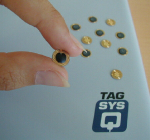Jul 03, 2003July 7, 2003 - French RFID systems provider Tagsys recently demonstrated a new 13.56 MHz RFID tag that the company says is highly suited for the pharmaceutical, medical and cosmetic industries. No bigger than a contact lens, the tag is based on the current 13.56 MHz Electronic Product Code (EPC) Class 1 specification developed by the Auto-ID Center.
The new tag contains a circular piece of silicon just 9 mm (0.35 inch) in diameter and less than 1 mm thick. At an Auto-ID Center board meeting held in Zurich, Switzerland, in late June, Tagsys showed that the tag can communicate at a 52 kilobit/second data rate with a Tagsys L200 EPC reader and with EPC-compliant readers made by Philips Semiconductor. The company demonstrated that these readers could read 150 tags per second.
"We expect to see the tag used in applications where the objects being tagged are small themselves, and where it is really impractical to have a large tag," says Alastair McArthur, Tagsys' chief technology officer. "Typically you see this in the pharmaceutical, cosmetic and medical industries, and in the jewelry industry, as well."
McArthur says that tags could be used to track plastic bottles of medicine and small plastic vials containing specimen samples, such as urine or blood.
"We've done some early work in the tagging of blood, and it's clearly very important to have good traceability of such items," says McArthur. "Whether all medical applications would require a very small tag is questionable -- some may be able to use a larger tag -- but small pill bottles and vials would require the smallest tags."
Tagsys also expects its tiny EPC tag will come in handy for makers of high-end makeup and perfumes, which are generally sold in small containers. The cosmetic industry could use the tags to identify their products as genuine and different them from counterfeit versions that sometimes appear on the market.
"We've heard that from some of the manufacturers in the sector," says McArthur. "There is certainly demand for product authentication and traceability mechanism -- to protect the brands of these items."
The best way to do that, McArthur believes, is to embed the tags in the containers holding the cosmetics so that the tags can't be easily removed from the item.
Tagsys specializes in high frequency (13.56 MHz) systems, and many of the applications it envisions for its EPC tags will involve liquids, which absorb radio waves in the UHF (900 MHz) band. Another benefit of using high frequency on individual items is that HF provides a well-defined read zone, which prevents readers from picking up tags on items that you may not want to read.
"HF creates a strong field out to a certain distance and then the field drops off rapidly, so you have a much better ability to clearly understand what items are in the field of interrogation," says McArthur. "You're less likely to see what I would call rogue tags, which are tags that are maybe passing by a shelf or in close proximity but not in the area that you really what to read."
McArthur expects the tag's maximum read range to be 3 to 5 centimeters. "We can image the items being tagged on their bases and being read on some sort of smart shelf or going down a conveyor belt with scanner underneath the conveyor belt reading the items," he says.
While the tags are protected by encapsulation and could be glued to those items, McArthur believes that for most applications, the tags will be embedded in items through the use of plastic-injection techniques. Anticipating this, Tagsys designed the tag to be robust enough to withstand the heat and pressure used in the plastic injection process.
McArthur says the tag can endure molding pressures between 30 and 35 bar and a temperature of 300 degrees C, but that the tag can survive temperatures as high 400 degrees C for very short periods of time. -- By Paul Prince


